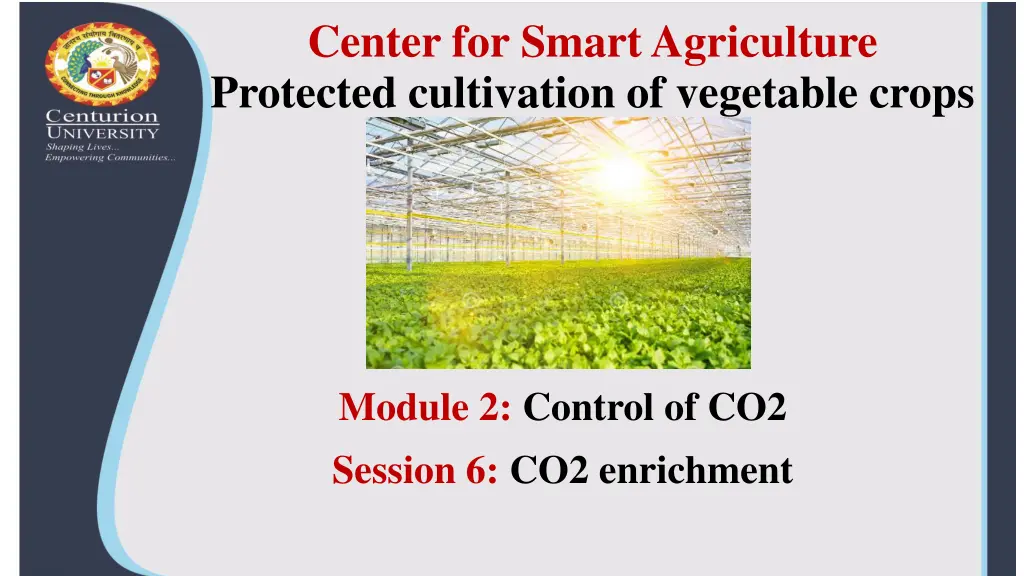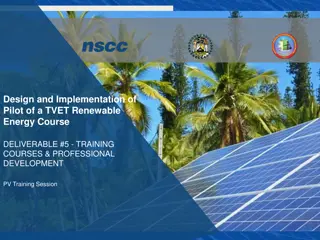
Smart Agriculture: CO2 Control for Protected Cultivation
Learn about monitoring and enriching CO2 levels in greenhouses for optimal crop production. Discover strategies like maximizing natural CO2 supply, using liquid/bottled CO2 gas, and harnessing CO2 from carbon-based fuels. Implement cost-effective methods to enhance plant health and yield.
Download Presentation

Please find below an Image/Link to download the presentation.
The content on the website is provided AS IS for your information and personal use only. It may not be sold, licensed, or shared on other websites without obtaining consent from the author. If you encounter any issues during the download, it is possible that the publisher has removed the file from their server.
You are allowed to download the files provided on this website for personal or commercial use, subject to the condition that they are used lawfully. All files are the property of their respective owners.
The content on the website is provided AS IS for your information and personal use only. It may not be sold, licensed, or shared on other websites without obtaining consent from the author.
E N D
Presentation Transcript
Center for Smart Agriculture Protected cultivation of vegetable crops Module 2: Control of CO2 Session 6: CO2 enrichment
CO2 levels in the greenhouse may be monitored using relatively low-cost dual beam infrared CO2 gas monitors. These monitors may be linked to climate control systems that integrate other factors such as indoor & outdoor air temperature, humidity & light intensity. More expensive monitors accuracies are available, applications reliability and economical cost are the most important factors. with but higher most in
Although basic CO2 dosing may be applied without monitoring CO2 levels, the relatively low cost of a good CO2 metering system pays for itself in the form of cost savings from supplemental CO2 sources. CO2 enrichment should however, if crop production and quality are below required levels. be considered,
Co2 enrichment 1. Maximize Natural (Free) CO2 Supply: Maximize ventilation possible starting 1 or 2 hours after sunrise when the overnight buildup of CO2 has been depleted. Improve horizontal air flow to distribute available CO2 evenly throughout the crop and to reduce the leaf boundary layer, which will improve the diffusion of CO2 into the stomatal openings of each leaf. rates whenever
Keep plants healthy and well-watered so they are not forced to close their stomatal openings due to stress. Depending on the crop, consider using natural sources of CO2 such as decomposing straw bales and/or organic soil mixes in your production system.
2. Liquid or Bottled CO2 Gas: When outside air conditions are too extreme for ventilation, additional CO2 is available in the form of liquid or bottled CO2 gas. Specific processes are required for the safe & proper handling as well as the effective use of CO2 from these sources. Liquid CO2 must be fully vaporized before delivering into the manufacturers instructions and local codes should be strictly adhered to. greenhouse, and
3. CO2 from Carbon-Based Fuels: Gas-fired appliances generate CO2 and water vapour as primary combustion. These appliances include equipment that is specifically designed & certified as CO2 generating appliances, un-vented forced-air primary space heaters, and hot water boiler heating systems with flue gas condensers specifically designed for CO2 enrichment. by-products of
Achieving complete combustion is the key to success of CO2 appliances burning natural or propane gas. Incomplete combustion may occur due to relatively common factors such as improper or fluctuating gas pressure, impurities in the gas supply, inadequate oxygen for combustion, wind disturbance in the burner clogged gas orifices. enrichment through
Harmful by-products of incomplete combustion include Nitrogen Oxides, Carbon Monoxide and Ethylene.






















